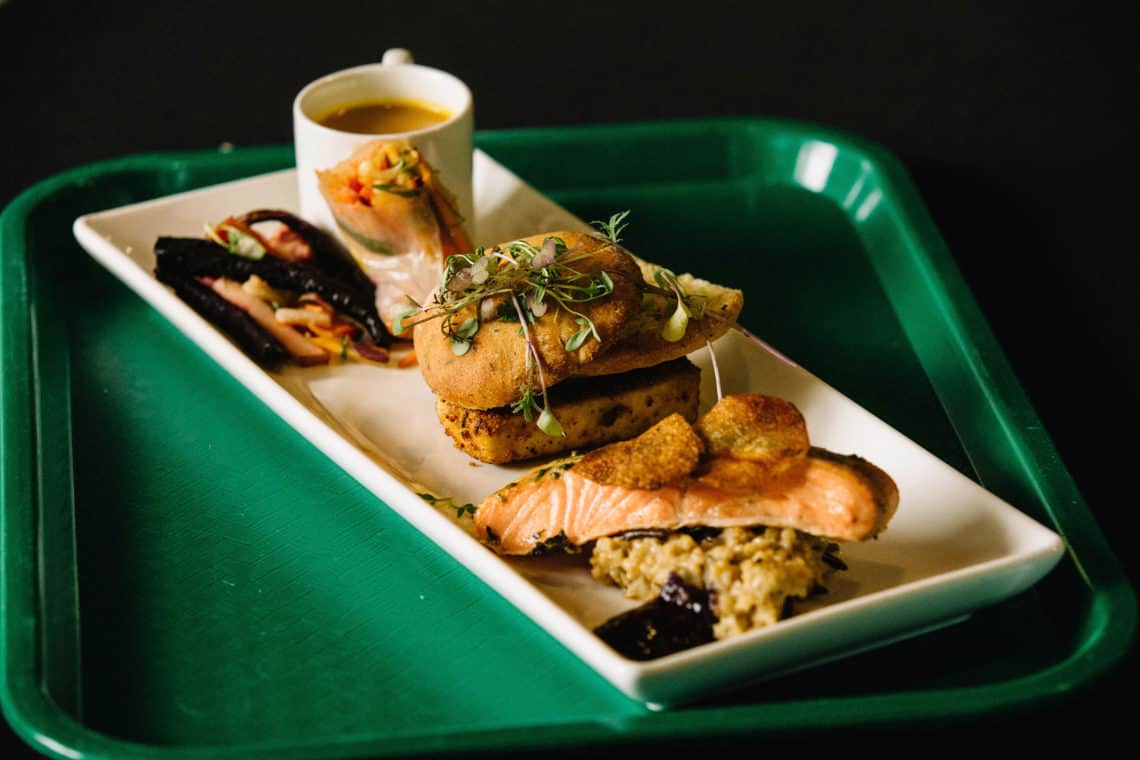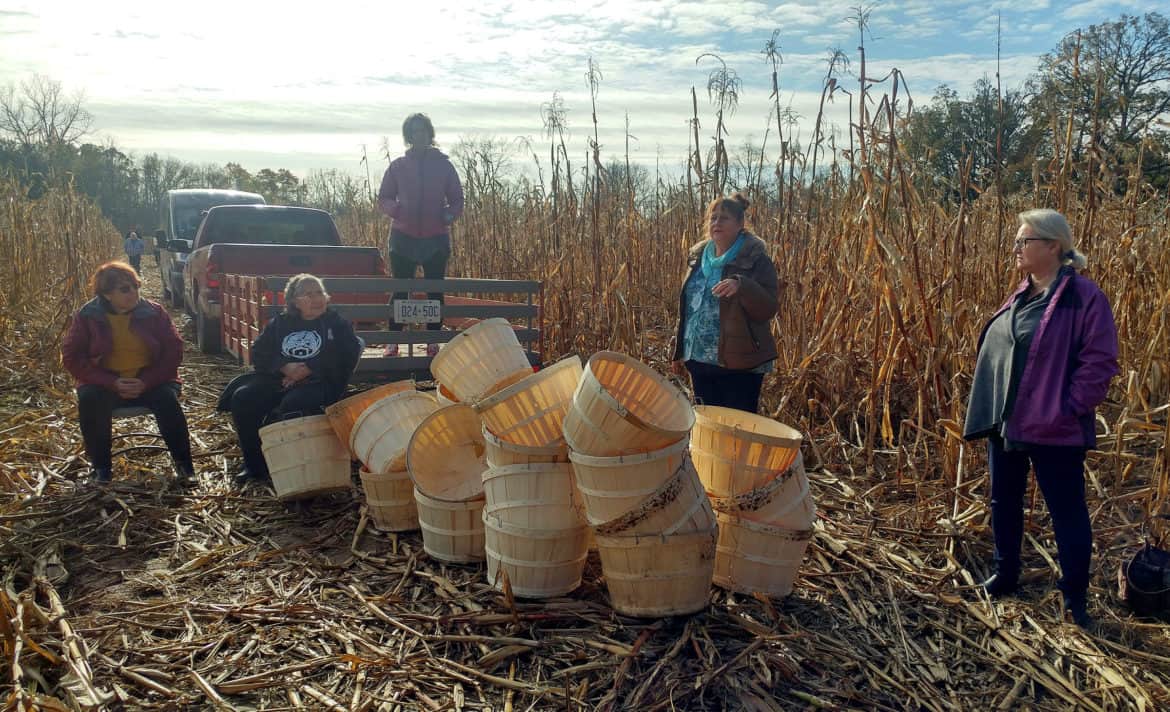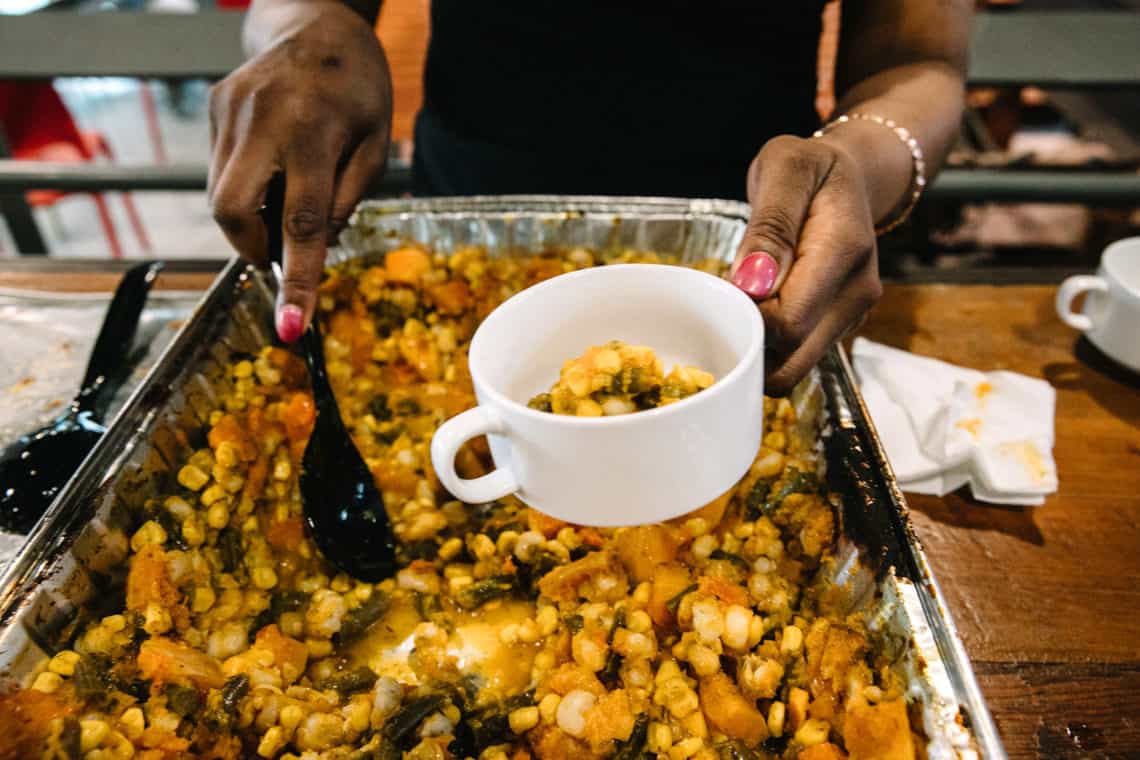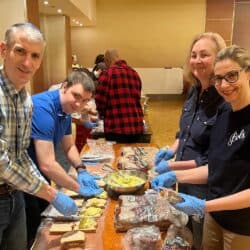For too long, “hospital food” has been synonymous with “bad food.” But an initiative called Nourish aims to change that association by focusing on the interface between food and healthcare systems.
“Hospital food.”
For most people, these two words are synonymous with “bad food,” conjuring unappetizing images of dry meatloaf, overcooked vegetables, and slippery jello.
For far too long, as André Picard wrote in a 2019 Globe and Mail op-ed, “feeding patients has been viewed as a chore, similar to doing the laundry – something that should be done as cheaply and efficiently as possible. The pervasive attitude, from clinicians to managers, [is] if someone is well enough to complain about the food, they’re well enough to go home.” Thankfully, he wrote, “there’s a hospital food revolution underway … to make what is served on the hospital tray more palatable, patient-friendly and planet-friendly.”
***
This is a story about a collaborative initiative called Nourish that focuses on the potential leverage for change in hospital food systems. The interface between different systems is often neglected territory for systems change because managerial structures govern silos, not critical interfaces between them. Focused on the interface between food and healthcare, the Nourish initiative aims to plant seeds for change in both. While in principle the healthcare system recognizes the importance of the social determinants of health, in practice hospital food has been treated as a cost to be minimized, rather than a way of advancing personal health while supporting both sustainably produced food and social inclusion through culturally appropriate menus.
Nourish is playing the role of a “field catalyst,” building an agile leadership community of diverse players with a shared commitment to change systems that none could accomplish on their own – an approach to systems innovation that we think holds lessons transferable to funders and practitioners working in other domains.
Nourish is a work in progress. Before describing how it accomplished tangible outcomes in its first phase, we should introduce the systems thinking that shaped its work.
Embracing the complexity of social systems
Systems thinking helps us understand how social systems behave. It includes concepts like dynamic complexity, which describes the non-obvious connections and surprises that can occur between intention, designed interventions, and outcomes. It helps us understand time delays when months or even years intervene between actions and their consequences. It includes tipping points, when systems shift quickly, for better or worse. Beyond technical features like these, social systems are different because they are social – that is, they are shaped by the actors in the system themselves. There is no system out there that exists separately from our ways of thinking and perceiving in here.
Social systems like schools, workplaces, families – or hospital food programs – are sustained by institutional and cultural norms, human beliefs, and prescribed activities. They connect “outer,” tangible artifacts like metrics, formal structures, and policies with “inner” mental models and behaviours that are often invisible.
Surprisingly for some, this means that real systems change is a very personal process. Practically speaking, where to draw boundaries depends on our purpose – the questions we want to ask and the problems we wish to address, and the realism of fostering leadership communities ready to do the hard work.

Photo by Connie Tsang.
Systems change thus traverses a complex inner-outer territory. “It is only through reflection that we change our history,” said Chilean biologist Humberto Maturana. Yet for people working on complex problems while also navigating a crisis like COVID-19, securing time and space for reflection can be difficult. Being open to seeing things differently is essential. Given that no one sees a complex problem fully, there is no alternative to building leadership communities that integrate diverse views. From here it becomes possible to build trusting peer networks, pool collective capacity to learn and innovate, and, eventually, forge shared visions and connect different strategies for changing systems.
Systems leaders are skilled at facilitating collaboration through their ability to raise system-level awareness among people in a particular field, through reflection and generative conversation. They help people shift from reactive problem-solving to co-creating alternative futures.
Nourish, at the nexus of two systems
The initial phase of the Nourish initiative was a collaboration hosted by the McConnell Foundation, with partners including Food Secure Canada, Health Care Without Harm, HealthCareCAN, the Sustainable Food Lab, the Canadian Coalition for Green Health Care, and the Academy for Systems Change. It grew out of efforts to encourage education and health institutions to procure and serve more local food. A cohort of 26 “Nourish Innovators” was recruited to take part in a two-year experiment that was part leadership development program, part change lab, and part community of practice. They came from small long-term-care homes, Indigenous health centres, large hospitals, and provincial health authorities. Individually they had responsibilities for setting menus, purchasing, or overseeing food services.
Nourish Innovators pursued projects to change food service within their own organizations, introducing traditional and cultural food programs; “room service” models where patients order from menus; waste audits; taste testing panels; local and organic food procurement involving local farmers, fishers, and entrepreneurs; and sustainability efforts such as reducing meat and packaging, planting gardens, and building beehives. In parallel, the Nourish staff of three developed a wider learning network of organizations, policy-makers, academics, and funders with “food for health” as an overarching theme.
While much work remains, by the end of the initial phase there were changes in thinking and practice, both within the healthcare sector and more broadly among food service companies and local providers. In external interviews at the end of the initial program, the sustainability manager of a national food service company commented, “Requests for local food [from healthcare customers] have risen more in the last year than in the last five put together.” Another interviewee noted that food in healthcare had become “a story with heart, rather than an esoteric topic. They’ve made it fun.” Perspectives like these point to the growing impact that the initiative continues to have at the institutional and policy levels across Canada, even through the pandemic.
Reflecting on Nourish’s journey so far, a few lessons stand out:
1. High-leverage change can be hiding in plain sight
Jay Forrester, the father of system dynamics, said that leverage points were counter-intuitive to most people’s thinking, shaped as it is by their experience in a system in which they are embedded as well as by familiarity with simple linear cause and effect.
In most hospitals, food is managed as part of operations, alongside parking and laundry. Kitchens are typically located out of sight in hospital basements. If asked about hospital food, most hospital executives would say they’re trying to increase patient satisfaction while controlling costs. The idea that food service can support better health outcomes is still uncommon. It is not part of clinical care.
And yet, we know food has an enormous influence on health. Healthy diets are associated with better physical and mental well-being and could help to reverse the mounting toll on human and fiscal health exacted by obesity, diabetes, and cardiovascular disease.
“Working with food has both immediate and far-reaching effects,” says Jennifer Reynolds, co-director of Nourish. “A beautiful meal on a patient’s tray tells someone that they are cared for – and connects them to community, culture, and the land. Eating well in hospital promotes healing and better self-care. People are motivated by the example that is set for them.”
Balancing a focus on acute care with prevention and population health strategies to keep people healthy and out of hospitals reveals food as a high-leverage investment in people’s well-being, rather than simply a cost to be controlled.
2. Hierarchy can obscure leverage points in a system
Healthcare is a highly structured, hierarchical system. Hospital boards, executives, and clinicians guide major investments in expansion and capital improvements. Food-service managers do not rank very high. Nonetheless, Nourish focused mainly on the middle managers who make daily decisions about food. Senior management support was required to join the cohort, but the participants were professionals, including food service directors, procurement managers, and dieticians. “We started out with a belief that these people had untapped desire and power to make changes and that with more information, tools, and peer support, they could make significant shifts in their organization’s procurement and provisioning,” says Nourish co-director Hayley Lapalme. “Being part of something larger than their organization gave them additional credibility as individuals and managers.”
When food service manager and Nourish Innovator Josée Lavoie arrived at Sainte-Justine Mother and Child Hospital in Montreal in 2009, major renovations to the 1954 kitchens were being planned, opening the door to deeper change. Her team and the hospital took the opportunity to rethink food service, moving to a “room service” model, in which patients choose from dietician-approved menus. Room service operates from 6:30 a.m. to 7 p.m., and meals are delivered to patients in under an hour.
“When you’re hospitalized,” Lavoie explains, “you lose control of so much. Room service restores choice to the patient and humanizes food service.” After the switch, patient satisfaction climbed from 50% to 99%. “We used to throw away 25% of what was on the food trays. Now our waste is only 5%. All of this was achieved with no change in the number of staff,” she adds.
Sainte-Justine is one of at least eight hospitals in Canada to introduce room service. All have experienced significant improvements in patient satisfaction and reduced food waste. After meeting Lavoie, Nourish Innovator Michelle Nelson helped convert her Alberta hospital to the model. Anecdotal evidence suggests that while it requires an initial investment and effort, it is associated with improved clinical outcomes and shorter hospital stays, warranting further study.
With Nourish’s support, Lavoie advocated for sustainability criteria to be included in her group buying association and worked with Quebec environmental organization Équiterre to secure more local and organic food. Savings from reductions in food waste offset higher prices, and hospital communications conveyed the importance of reduced pesticides in food served to young patients. Still, it has been an uphill battle to make changes to distribution channels and entrenched group buying relationships with other hospitals.
The accomplishments of the Nourish Innovators show how talented “intrapreneurs” can make change within their own organizations by generating credible and compelling proofs of concept that make it easier to obtain the support of senior leaders.
3. The power of peers
A well-known East African proverb says, “If you want to go fast, go alone; if you want to go far, go together.” Like their entrepreneurial counterparts, intrapreneurs can feel isolated, unappreciated, and disconnected from a learning community that strengthens and sustains their efforts. Being part of a peer cohort can provide guidance and critical feedback from people who share their challenges and aspirations.
Kathy Loon, traditional programs manager and food service director at the Meno Ya Win Health Centre in Sioux Lookout in northwestern Ontario, wanted to offer more “traditional food” to Indigenous patients. She manages the Miichim (Ojibway for food) program, which brings wild food and game to patients who want a traditional meal, serving foods like moose, caribou, deer, partridge, rabbit, and blueberries.
“From a holistic perspective, when you are sick physically, you are sick spiritually as well,” Loon says. “Bringing a traditional meal to somebody can make them forget their situation, for even a brief moment. Eating something that’s culturally normal can increase Indigenous patients’ comfort, enjoyment, and happiness.”
The Miichim program is supported by the hospital board, its CEO, and senior directors. “Getting to the point that we can do one or two meals like this a week is not a one-person job. It takes a whole hospital to do it.”
Four hundred kilometres away, in Thunder Bay, is another Nourish Innovator named Dan Munshaw. As the city’s manager of supply management, Munshaw had worked to bring more local food into long-term-care homes and other venues by creating “forward-buying contracts” with local producers, in which the buyer commits to a seasonal purchase, lowering the risk for local producers and assuring more reliable supply.
Munshaw’s work on local food was a success, but he knew little about Indigenous Peoples’ access to traditional food until he met Loon. Inspired by her passion to bring culture into the care of Meno Ya Win patients, Munshaw became determined to serve Indigenous and traditional foods at the City of Thunder Bay’s stadiums and arenas, by buying foods from traditional suppliers, growers, and harvesters. He used his government contacts to establish a food-sharing partnership between the Ministry of Natural Resources and Meno Ya Win, in which the ministry donates confiscated meat and wild game. With this partnership, the Meno Ya Win Health Centre has been able to increase the amount of Miichim food that they serve to patients. “I’m not a First Nations person; I’m a [settler] business person,” Munshaw says. “I wanted to adapt public procurement in a way that was not colonial. It’s not just about buying a few things – it’s doing it in a way that recognizes and respects other cultures.”
Over time, Indigenous Innovators and advisors became a gentle but strong presence in the Nourish cohort. There was space and time for Indigenous traditions in gatherings and for Indigenous Innovators, Elders, and advisors to share their experiences and wisdom. By the end of the two-year cohort, most participating organizations had begun to explore the use of culturally appropriate food as a pathway to reconciliation.
4. Learning how to think together
For Nourish, shared reflection was key to systems change. It was expressed in the approach to meetings, which created a “vessel” that fostered a sense of mutuality, trust, and psychological safety. Meetings made use of various peer-learning approaches to adult education (such as Liberating Structures), design thinking, and approaches to “awareness-based systems change.” They were also guided by Indigenous ways of gathering and by Indigenous insights into social trauma stemming from the residential school system.
“The conversations were not always easy,” Lapalme says. “We experienced difficulty discussing healthcare institutions’ role in Indigenous reconciliation, in defining ‘healthy food,’ and around the trade-offs needed to prioritize local and sustainable sourcing. But these conversations deepened our understanding, built trust, and ultimately led to stronger action.”
Nourish found that maintaining and strengthening relationships can be supported remotely, which is necessary in a geographically distributed initiative. What a community of peers accomplishes ultimately depends less on technology than on the quality of relationships, and the work done together – what the Innovators called a “learn and do” community. Today, online convening is helping Nourish nurture genuine connectedness, not just manage tasks, at a distance.
5. The power of grounding learning in reality
Nourish gatherings were used to ground Innovators in the reality of the systems they were attempting to shift. Borrowing a method used by the Sustainable Food Lab, Nourish included “learning journeys” in each of the Innovator retreats.
“Learning journeys are not just typical field trips,” says Food Lab co-founder and Nourish advisor Hal Hamilton. They “help people reflect together on how they encounter and make sense of complex realities. Travel together is as important as time at a site. It is amazing how 10 people on the same visit see 10 different things. The conversations that ensue are tremendous opportunities to appreciate different ways of seeing.” (The Presencing Institute provides a basic protocol for learning or “sensing” journeys.)

Visits to farms during learning journeys brought some surprising insights for the Nourish Innovators. On one journey, they visited both an organic and a conventional potato farm and found that putting the farmer’s face to the food both deepened and humanized their understanding of different production systems.
Nourish also convened senior federal, provincial, and territorial government officials, providing them with comparisons of their jurisdiction’s policies and inspiring examples from Canada and abroad. A senior official from US health giant Kaiser Permanente explained how junk food was eliminated from the hospitals it manages. A Danish physician described the arduous but ultimately successful process of radically increasing the percentage of organic food served in Copenhagen schools and seniors’ homes. And a selection of Nourish Innovators presented the work they’d done changing food in facilities across Canada.
Indigenous traditional and cultural learning was woven into all programming, both on the land and with Elders at meetings. Speaking at the closing event in Toronto, an Elder from Haida Gwaii told the audience of 200, “It’s good that Nourish has listened to the wisdom of women Elders – you people should do this more often!”
6. Resourcing collaborative innovation
About six months into the program, McConnell established a funding pot of $100,000 for collaborative projects. Proposed projects had to involve a challenge that could not be solved by any one organization and had to be led by a team of at least three Innovators.
The selection process was an experiment in virtual collaboration. The 26 Innovators generated 14 project ideas. They selected seven to develop and “pitched” five to their colleagues during online sessions. The other Innovators, advisors, and mentors provided feedback and recommendations that refined the project ideas. Projects included development of a values-based request for proposals from food suppliers, an interactive online guide to creating sustainable menus, and a process to influence provincial food policy on local foods. All five of the final projects were funded, and each succeeded in securing significantly more support from governments, hospital budgets, and partner organizations.
Further funding diversification occurred when the Arrell Family Foundation joined McConnell in supporting the Nourish team’s plan to expand its work and spin off as an independent non-profit. At the height of the pandemic, the Frontline Fund of 100 hospital foundations provided resources for Nourish to support Indigenous emergency food-security projects. It is important to note that systems change work like this requires a sustained funding commitment and cannot be accomplished with short-term, project-based grants.
7. Changing narratives to shift mindsets
A sure way to generate negative social media is to ask people to describe their food experience in hospitals. This was a painful and contested stereotype for Nourish participants who had devoted their careers to serving good food to patients. Tellingly, negative narratives about hospital food also exist inside the health system. When doctors enter a hospital room to visit patients, they will sometimes strike up a conversation with “So, how bad was the food today?” Such comments reinforce the perception that food is secondary to healthcare. After all, would a doctor joke about the quality of medication?
The stories we tell and the expressions we use not only reflect our mindsets, they also hold potential as vehicles for shifting them. In her seminal book Thinking in Systems, Donella Meadows summarizes places to intervene in a complex system, the “leverage points,” where a small shift in one thing can produce big changes in everything – and shift the paradigms that guide that system. Paradigms are held in place by the stories we tell, and from early on Nourish focused on creating narratives to expand hospitals’ paradigms beyond quality and cost of medical treatment to include longer-term personal, cultural, and planetary health and well-being through food.
With the help of a communications specialist, the Nourish team studied the narratives of key stakeholders, including food-service directors, physicians, chefs, and hospital CEOs. “When CEOs publicly shift their narrative from ‘Food is a cost centre, low on my long list of priorities,’ to ‘Making good food a visible priority at our hospital demonstrates leadership and innovation,’ we see far-reaching effects,” Reynolds says.
The team also identified chefs as passionate, influential advocates. They recruited three celebrity chefs to each work with a hospital to create recipes that were “patient- and planet-friendly” as well as practical in a healthcare setting. At the Food for Health Symposium at Evergreen Brick Works in Toronto, which concluded Nourish’s first phase, a mini-version of each meal was served to the 200 attendees, who voted on their favourites. The chefs attracted mainstream media and used their own social media platforms to draw attention to Nourish. The panel of judges included a dietician, a doctor, two kids, and Globe and Mail health columnist André Picard, whose quote opens this article.

Photo by Connie Tsang.
8. Deepening resilience by redrawing the boundaries of “inside” and “outside”
When we stop seeing “systems” as objective external realities separate from ourselves, we realize that what we view as inside or outside systems is not fixed or immutable. Where we draw boundaries around a system depends on our purpose – the questions we want to ask and the problems we wish to address.
In the first phase of Nourish, the systems boundary was focused primarily around middle managers in healthcare food service, municipal long-term-care facility procurement managers, and directors of patient well-being at provincial health authorities. The experience demonstrated that changing food service within individual healthcare facilities is necessary but insufficient to reach the goal of food being understood as fundamental to health. This will require broader shifts in mindsets, policies, and widespread practices.
Building on its initial phase, Nourish now aims to expand its core collaborators to include CEOs, physicians, nurses, community organizations, policy-makers, food-service companies, and local food producers in a community of systems leaders.
As the boundary of Nourish’s focus is redrawn, the work of developing systems leadership communities will thus enter a new phase in the search for leverage in unusual places to build health for people and the planet. With the efforts of dedicated systems leaders, wherever they may sit, even a humble hospital tray can be the starting place for changing the world.
For more information on the role of McConnell Foundation in supporting this collaboration and their 10-year, $14-million Sustainable Food Systems Initiative, please read the complementary story on PhiLab’s website here.


